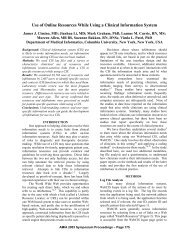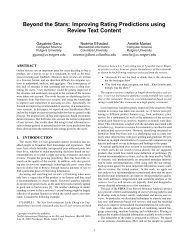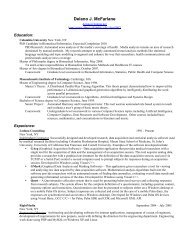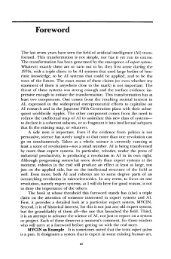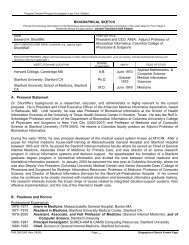Rule-Based Expert Systems: The MYCIN Experiments of the - People
Rule-Based Expert Systems: The MYCIN Experiments of the - People
Rule-Based Expert Systems: The MYCIN Experiments of the - People
Create successful ePaper yourself
Turn your PDF publications into a flip-book with our unique Google optimized e-Paper software.
References<br />
Abelson, R. 1973. <strong>The</strong> structure <strong>of</strong> belief systems. In Computer Models <strong>of</strong><br />
Thought and Language, eds. R. C. Schank and K. M. Colby, pp. 287-<br />
339. San Francisco: Freeman.<br />
Adams, J. B. 1976. A probability model <strong>of</strong> medical reasoning and <strong>the</strong><br />
<strong>MYCIN</strong> model. Ma<strong>the</strong>matical<br />
Chapter 12 in this volume.)<br />
Biosciences 32: 177-186. (Appears as<br />
Aiello, N. 1983. A comparative study <strong>of</strong> control strategies for expert systems:<br />
AGE implementation <strong>of</strong> three variations <strong>of</strong> PUFE In Proceedings<br />
<strong>of</strong> <strong>the</strong> Third National Conference on Artificial Intelligence, pp. 1-4.<br />
Aiello, N., and Nii, H. E 1981. AGE-PUFF: A simple event-driven program.<br />
Report no. HPP-81-25, Computer Science Department,<br />
ford University<br />
Stan-<br />
Aikins, J. S. 1979. Prototypes and production rules: An approach to knowledge<br />
representation for hypo<strong>the</strong>sis formation. In Proceedings <strong>of</strong> <strong>the</strong> 6th<br />
International Joint Conference on Artificial Intelligence (Tokyo), pp. 1-3.<br />
(Appears with revisions as Chapter 23 <strong>of</strong> this volume.)<br />
¯ 1980. Prototypes and production rules: a knowledge representation<br />
for computer consultations. Ph.D. dissertation, Stanford University.<br />
(Also Stanford Report no. STAN-CS-80-814.)<br />
¯ 1983. Prototypical knowledge for expert systems. Artificial<br />
gence 20(2): 163-210.<br />
Intelli-<br />
Aikins, J. S., Kunz, J. C., Shortliffe, E. H., and Fallat, R.J. 1983. PUFF:<br />
An expert system for interpretation <strong>of</strong> pulmonary function data. Computers<br />
and Biomedical Research 16: 199-208.<br />
Allen, J. 1978. Anatomy <strong>of</strong> LISP. New York: McGraw-Hill.<br />
Anderson, J. 1976. Language, Memory and Thought. Hillsdale, NJ: Erlbaum.<br />
Anthony, J. R. 1970. Effect on deciduous and permanent teeth <strong>of</strong> tetracycline<br />
deposition in utero. Postgraduate Medicine 48(4): 165-168.<br />
Barker, S. F. 1957. Induction and Hypo<strong>the</strong>sis: a Study <strong>of</strong> <strong>the</strong> Logic <strong>of</strong> Confirmation.<br />
Ithaca, NY: Cornell University Press.<br />
Barnett, J. A. 1981. Computational methods for a ma<strong>the</strong>matical <strong>the</strong>ory <strong>of</strong><br />
evidence. In Proceedings <strong>of</strong> <strong>the</strong> 7th International Joint Conference on Artificial<br />
Intelligence (Vancouver, B.C.), pp. 868-875.<br />
Barnett, J. A., and Erman, L. 1982. Making control decisions in an expert<br />
system is a problem-solving task. Technical report, Information Sciences<br />
Institute, University <strong>of</strong> Sou<strong>the</strong>rn California.<br />
Barr, A., and Feigenbaum, E. A. (eds.). 1981, 1982. <strong>The</strong> Handbook <strong>of</strong> Artificial<br />
Intelligence (vols. 1, 2). Los Altos, CA: Kaufmann.<br />
717
718 References<br />
Barr, A., Beard, M., and Atkinson, R. C. 1976. <strong>The</strong> computer as a tutorial<br />
laboratory: <strong>The</strong> Stanford BIP project. International Journal <strong>of</strong> Man-<br />
Machine Studies 8: 567-596.<br />
Bartlett, E C. 1932. Remembering: A Study in Experimental and Social Psychology.<br />
Cambridge, U.K.: Cambridge University Press.<br />
Bennett, J. S. 1983. ROGET: A knowledge-based consultant for acquiring<br />
<strong>the</strong> conceptual structure <strong>of</strong> an expert system. Report no. HPP-83-24,<br />
Computer Science Department, Stanford University.<br />
Bennett, J. S., and Goldman, D. 1980. CLOT: A knowledge-based consultant<br />
for bleeding disorders. Report no. HPP-80-7, Computer Science<br />
Department, Stanford University.<br />
Bennett, J. S., and Hollander, C. R. 1981. DART: An expert system for<br />
computer fault diagnosis. In Proceedings <strong>of</strong> <strong>the</strong> 7th International Joint<br />
Conference on Artificial Intelligence (Vancouver, B.C.), pp. 843-845.<br />
Bennett, J. S., Creary, L., Engelmore, R., and Melosh, R. 1978. SACON:<br />
A knowledge-based consultant for structural analysis. Report no. HPP-<br />
78-23, Computer Science Department, Stanford University.<br />
Bisch<strong>of</strong>f, M., Shortliffe, E. H., Scott, A. C., Carlson, R. W., and Jacobs, D.<br />
1983. Integration <strong>of</strong> a computer-based consultant into <strong>the</strong> clinical setting.<br />
In Proceedings <strong>of</strong> <strong>the</strong> 7th Symposium on Computer Applications in Medical<br />
Care (Baltimore, MD), pp. 149-152.<br />
Blum, B. I., Lenhard, R., and McColligan, E. 1980. Protocol directed patient<br />
care using a computer. In Proceedings <strong>of</strong> 4th Symposium on Computer<br />
Applications in Medical Care (Washington, D.C.), pp. 753-761.<br />
Blum, R. L. 1982. Discovery and representation <strong>of</strong> causal relationships<br />
from a large time-oriented clinical database: <strong>The</strong> RX project. Ph.D.<br />
dissertation, Stanford University. (Also in Computers and Biomedical Research<br />
15: 164-187.)<br />
Bobrow, D. G. 1968. Natural language input for a computer problemsolving<br />
system. In Semantic Information Processing, ed. M. Minsky, pp.<br />
146-226. Cambridge, MA: MIT Press.<br />
Bobrow, D. G., and Winograd, T. 1977. An overview <strong>of</strong> KRL, a knowledge<br />
representation language. Cognitive Science 1: 3-46.<br />
Bobrow, D. G., Kaplan, R. M., Kay, M., Norman, D., Thompson, H., and<br />
Winograd, T. 1977. GUS: A frame-driven dialog system. Artificial<br />
telligence 8: 155-173.<br />
In-<br />
Bobrow, R. J., and Brown, J. S. 1975. Systematic understanding: Syn<strong>the</strong>sis,<br />
analysis and contingent knowledge in specialized understanding systems.<br />
In Representation and Understanding: Studies in Cognitive Science,<br />
eds. D. G. Bobrow and A. Collins,<br />
Press.<br />
pp. 103-129. New York: Academic<br />
Bonnet, A. 1981. LITHO: An expert system for lithographic analysis. Internal<br />
working paper, Schlumberger Corp., Paris, France.<br />
Boyd, E. 1935. <strong>The</strong> Growth <strong>of</strong> <strong>the</strong> Surface Area <strong>of</strong> <strong>the</strong> Human Body. Minneapolis:<br />
University <strong>of</strong> Minnesota Press.
References 719<br />
Brachman, R. J. 1976. What’s in a concept: Structural foundations for<br />
semantic networks. Report no. 3433, Bolt Beranek and Newman.<br />
Bransford, J., and Franks, J. 1971. <strong>The</strong> abstraction <strong>of</strong> linguistic ideas.<br />
Cognitive Psychology 2:331-350.<br />
Brown, J. S., and Burton, R. R. 1978. Diagnostic models for procedural<br />
bugs in ma<strong>the</strong>matical skills. Cognitive Science 2: 155-192.<br />
Brown, J. S., and Goldstein, I. E 1977. Computers in a learning society.<br />
Testimony for <strong>the</strong> House Science and Technology Subcommittee on<br />
Domestic and International<br />
tober, 1977.<br />
Planning, Analysis and Cooperation, Oc-<br />
Brown, J. S., and VanLehn, K. 1980. Repair <strong>the</strong>ory: A generative <strong>the</strong>ory<br />
<strong>of</strong> bugs in procedural skills. Cognitive Science 4(4): 379-426.<br />
Brown, J. S., Burton, R. R., and Zydbel, E 1973. A model-driven questionanswering<br />
system for mixed-initiative computer-assisted instruction.<br />
IEEE Transactions on <strong>Systems</strong>, Man, and Cybernetics SMC-3(3): 248-257.<br />
Brown, J. S., Burton, R. R., and Bell, A. G. 1974. SOPHIE: A sophisticated<br />
instructional environment for teaching electronic troubleshooting (an<br />
example <strong>of</strong> AI in CAI). Report no. 2790, Bolt Beranek and Newman.<br />
Brown, J. S., Burton, R., Miller, M., de Kleer, J., Purcell, S., Hausmann,<br />
C., and Bobrow, R. 1975. Steps toward a <strong>the</strong>oretic foundation for<br />
complex knowledge-based<br />
Newman.<br />
CAI. Report no. 3135, Bolt Beranek and<br />
Brown, J. S., Rubenstein, R., and Burton, R. 1976. Reactive learning environment<br />
for computer-aided electronics instruction. Report no.<br />
3314, Bolt Beranek and Newman.<br />
Brown, J. S., Burton, R. R., and de Kleer, J. 1982. Pedagogical, natural<br />
language, and knowledge engineering techniques in SOPHIE I, II,<br />
and III. In Intelligent Tutoring <strong>Systems</strong>, eds. D. Sleeman and J. S. Brown,<br />
pp. 227-282. London: Academic Press.<br />
Bruce, B. C. 1975. Generation as a social action. In Proceedings <strong>of</strong> <strong>the</strong> Conference<br />
on <strong>The</strong>oretical Issues in Natural Language Processing, pp. 74-77.<br />
Buchanan, B. G., and Duda, R. O. 1983. Principles <strong>of</strong> rule-based expert<br />
systems. In Advances in Computers (vol. 22), ed. M. C. Yovits, pp. 164-<br />
216. New York: Academic Press.<br />
Buchanan, B. G., and Feigenbaum, E. A. 1978. DENDRAL and Meta-<br />
DENDRAL: <strong>The</strong>ir applications dimension. Artificial<br />
24.<br />
Intelligence 11 : 5-<br />
Buchanan, B. G., and Mitchell, T. 1978. Model-directed learning <strong>of</strong> production<br />
rules. In Pattern-Directed Inference <strong>Systems</strong>, eds. D. Waterman<br />
and E Hayes-Roth, pp. 297-312. New York: Academic Press.<br />
Buchanan, B. G., Su<strong>the</strong>rland, G., and Feigenbaum, E. A. 1970. Rediscovering<br />
some problems <strong>of</strong> artificial intelligence in <strong>the</strong> context <strong>of</strong> organic<br />
chemistry. In Machine Intelligence 5, eds. B. Meltzer and D. Michie, pp.<br />
209-254. Edinburgh, U.K.: Edinburgh University Press.
720 References<br />
Buchanan, B. G., Mitchell, T. M., Smith, R. G., and Johnson, C. R., Jr.<br />
1978. Models <strong>of</strong> learning systems. In Encyclopedia <strong>of</strong> Computer Science<br />
and Technology 11, ed. J. Belzer, pp. 24-51. New York: Marcel Dekker.<br />
Bullwinkle, C. 1977. Levels <strong>of</strong> complexity in discourse for anaphora disambiguation<br />
and speech act interpretation. In Proceedings <strong>of</strong> <strong>the</strong> 5th<br />
International Joint Conference on Artificial<br />
pp. 43-49¯<br />
Intelligence (Cambridge, MA),<br />
Burton, R. R. 1976. Semantic grammar: An engineering technique for<br />
constructing natural language understanding systems. Report no.<br />
3453, Bolt Beranek and Newman¯<br />
¯1979. An investigation <strong>of</strong> computer coaching for informal learning<br />
activities¯ International Journal <strong>of</strong> Man-Machine Studies 11 : 5-24.<br />
Burton, R. R., and Brown, J. S. 1982. An investigation <strong>of</strong> computer coaching<br />
for informal learning activities¯ In Intelligent Tutoring <strong>Systems</strong>, eds.<br />
D. Sleeman and J. S. Brown, pp. 79-98¯ New York: Academic Press.<br />
Carbonell, J. R. 1970a. AI in CAI: An artificial-intelligence approach to<br />
computer-assisted instruction¯ IEEE Transactions on Man-Machine <strong>Systems</strong>,<br />
MMS-11: 190-202¯<br />
--. 1970b. Mixed-initiative man-computer instructional dialogues¯ Report<br />
no. 1971, Bolt Beranek and Newman¯<br />
Carbonell, J. R., and Collins, A. M. 1973. Natural semantics in artificial<br />
intelligence¯ In Advance Papers <strong>of</strong> <strong>the</strong> 3rd International Joint Conference<br />
on Artificial Intelligence (Stanford, CA), pp. 344-351.<br />
Carden, T. S. 1974. <strong>The</strong> antibiotic<br />
19.<br />
problem (editorial)¯ New Physician 23:<br />
Carnap, R. 1950. <strong>The</strong> two concepts <strong>of</strong> probability¯ In Logical Foundations<br />
<strong>of</strong> Probability, pp. 19-51. Chicago: University <strong>of</strong> Chicago Press¯<br />
--. 1962. <strong>The</strong> aim <strong>of</strong> inductive logic. In Logic, Methodology, and Philosophy<br />
<strong>of</strong> Science, eds. E. Nagel, E Suppes, and A. Tarski, pp. 303-318.<br />
Stanford, CA: Stanford University Press¯<br />
Carr, B., and Goldstein, I. 1977. Overlays: A <strong>the</strong>ory <strong>of</strong> modeling for CAI.<br />
Report no. 406, Artificial Intelligence Laboratory, Massachusetts Institute<br />
<strong>of</strong> Technology¯<br />
Chandrasekaran, B., Gomez, E, Mittal, S., and Smith,J. 1979. An approach<br />
to medical diagnosis based on conceptual schemes. In Proceedings <strong>of</strong><br />
<strong>the</strong> 6th International Joint Conference on Artificial Intelligence (Tokyo), pp.<br />
134-142.<br />
Charniak, E. 1972. Toward a model <strong>of</strong> children’s story comprehension.<br />
Report no. AI TR-266, Artificial Intelligence Laboratory, Massachusetts<br />
Institute <strong>of</strong> Technology¯<br />
¯ 1977. A framed painting: <strong>The</strong> representation <strong>of</strong> a common sense<br />
knowledge fragment¯ Journal <strong>of</strong> Cognitive Science 1(4): 355-394¯<br />
1978. With a spoon in hand this must be <strong>the</strong> eating frame. In<br />
Proceedings <strong>of</strong> <strong>the</strong> 2nd Conference on <strong>The</strong>oretical Issues in Natural Language<br />
Processing, pp. 187-193.
References 721<br />
Charniak, E., Riesbeck, C., and McDermott, D. 1980. Artificial Intelligence<br />
Programming. Hillsdale, N J: Erlbaum.<br />
Chi, M. T. H., Feltovich, P. J., and Glaser, R. 1980. Representation <strong>of</strong><br />
physics knowledge by experts and novices. Report no. 2, Learning<br />
Research and Development Center, University <strong>of</strong> Pittsburgh.<br />
Ciesielski, V. 1980. A methodology for <strong>the</strong> construction <strong>of</strong> natural language<br />
front ends for medical consultation systems. Ph.D. dissertation, Rutgers<br />
University. (Also Technical Report no. CBM-TR-112.)<br />
Clancey, W. J. 1979a. Dialogue management for rule-based tutorials. In<br />
Proceedings <strong>of</strong> <strong>the</strong> 6th International Joint Conference on Artificial Intelligence<br />
(Tokyo), pp. 155-161.<br />
1979b. Transfer <strong>of</strong> rule-based expertise through a tutorial dialogue.<br />
Ph.D. dissertation, Computer Science Department, Stanford<br />
University. (Also Stanford Report no. STAN-CS-769.)<br />
1979c. Tutoring rules for guiding a case method dialogue. International<br />
Journal <strong>of</strong> Man-Machine Studies 11: 25-49. (Edited version appears<br />
as Chapter 26 <strong>of</strong> this volume.)<br />
1981. Tutoring rules for guiding a case method dialogue. In Intelligent<br />
Tutoring <strong>Systems</strong>, eds. D. H. Sleeman and J. S. Brown, pp. 201-<br />
225. New York: Academic Press. (Same as Clancey, 1979c.)<br />
1983a. <strong>The</strong> advantages <strong>of</strong> abstract control knowledge in expert<br />
system design. In Proceedings <strong>of</strong> <strong>the</strong> 3rd National Conference on Artificial<br />
Intelligence (Washington, D.C.), pp. 74-78.<br />
1983b. <strong>The</strong> epistemology <strong>of</strong> a rule-based expert system: A framework<br />
for explanation. Artificial Intelligence 20:215-251. (Appears as<br />
Chapter 29 in this volume.)<br />
1984. Methodology for building an intelligent tutoring system. In<br />
Methods and Tactics in Cognitive Science, eds. W. Kintsch, J. R. Miller,<br />
and P. G. Poison. Hillsdale, NJ: Erlbaum. Forthcoming.<br />
Clancey, W. J., and Letsinger, R. 1981. NEO<strong>MYCIN</strong>: Reconfiguring a rulebased<br />
expert system for application to teaching. In Proceedings <strong>of</strong> <strong>the</strong><br />
7th International Joint Conference on Artificial<br />
B.C.), pp. 829-836.<br />
Intelligence (Vancouver,<br />
Clark, K. L., and McCabe, EG. 1982. PROLOG: a language for implementing<br />
expert systems. In Machine Intelligence, eds. J. Hayes, D. Michie,<br />
and Y. Pao, pp. 455-470. New York: John Wiley.<br />
Cohen, P. R., and Feigenbaum, E. A. (eds.). 1982. <strong>The</strong> Handbook <strong>of</strong> Artificial<br />
Intelligence (vol. 3). Los Altos, CA: Kaufmann.<br />
Cohen, S. N., Armstrong, M. E, Briggs, R. L., Chavez-Pardo, R., Feinberg,<br />
L. S., Hannigan, J. E, Hansten, E D., Hunn, G. S., Illa, R. V., Moore,<br />
T. N., Nishimura, T. G., Podlone, M. D., Shortliffe, E. H., Smith, L.<br />
A., and Yosten, L. 1974. Computer-based monitoring and reporting<br />
<strong>of</strong> drug interactions. In Proceedings <strong>of</strong> MEDINFO IFIP Conference<br />
(Stockholm, Sweden), pp. 889-894.<br />
Colby, K. M. 1981. Modeling a paranoid mind. Behavioral and Brain Sciences<br />
4(4): 515-560.
722 References<br />
Colby, K. M., Parkinson, R. C., and Faught, B. 1974¯ Pattern-matching<br />
rules for <strong>the</strong> recognition <strong>of</strong> natural language dialogue expressions¯<br />
Report no. AIM-234, Stanford Artificial Intelligence Laboratory, Stanford<br />
University.<br />
Collins, A. 1976. Processes in acquiring knowledge. In Schooling and Acquisition<br />
<strong>of</strong> Knowledge, eds. R. C. Anderson, R. J. Spiro, and W. E.<br />
Montague, pp. 339-363¯ Hillsdale, N J: Erlbaum.<br />
¯ 1978. Fragments <strong>of</strong> a <strong>the</strong>ory <strong>of</strong> human plausible reasoning¯ In<br />
Proceedings <strong>of</strong> <strong>the</strong> 2nd Conference on <strong>The</strong>oretical Issues in Natural Language<br />
Processing, pp. 194-201.<br />
Conchie, J. M., Munroe, J. D., and Anderson, D. O. 1970. <strong>The</strong> incidence<br />
<strong>of</strong> staining <strong>of</strong> permanent teeth by <strong>the</strong> tetracyclines. Canadian Medical<br />
Association Journal 103:351-356.<br />
Cooper, G. E 1984. NESTOR: A medical decision support system that<br />
integrates causal, temporal, and probabilistic knowledge¯ Ph.D. dissertation,<br />
Computer Science Department, Stanford University. Forthcoming.<br />
Cronbach, L.J. 1970. Essentials <strong>of</strong> Psychological Testing¯ New York: Harper<br />
and Row.<br />
Cullingford, R. 1977. Script application: Computer understanding <strong>of</strong><br />
newspaper stories¯ Ph.D. dissertation, Yale University¯<br />
Cumberbatch, J., and Heaps, H. S. 1973. Application <strong>of</strong> a non-Bayesian<br />
approach to computer aided diagnosis <strong>of</strong> upper abdominal pain. International<br />
Journal <strong>of</strong> Biomedical Computing 4:105-115.<br />
Cumberbatch, J., Leung, V. K., and Heaps, H. S. 1974. A non-probabilistic<br />
method for automated medical diagnosis¯ International Journal <strong>of</strong><br />
Biomedical Computing 5: 133-146.<br />
Davis, R. 1976. Applications <strong>of</strong> meta-level knowledge to <strong>the</strong> construction,<br />
maintenance, and use <strong>of</strong> large knowledge bases. Ph.D. dissertation,<br />
Computer Science Department, Stanford University¯ (Reprinted with<br />
revisions in Davis and Lenat, 1982¯)<br />
¯ 1977a. Generalized procedure calling and content-directed invocation.<br />
SIGPLAN Notices 12(8): 45-54¯<br />
¯ 1977b. Interactive transfer <strong>of</strong> expertise: Acquisition <strong>of</strong> new inference<br />
rules¯ In Proceedings <strong>of</strong> <strong>the</strong> 5th International Joint Conference on<br />
Artificial Intelligence (Cambridge, MA), pp. 321-328.<br />
1978. Knowledge acquisition in rule-based systems: Knowledge<br />
about representations as a basis for system construction and maintenance.<br />
In Pattern-Directed Inference <strong>Systems</strong>, eds. D. A. Waterman and<br />
E Hayes-Roth, pp. 99-134¯ New York: Academic Press¯<br />
¯ 1979. Interactive transfer <strong>of</strong> expertise: Acquisition <strong>of</strong> new inference<br />
rules¯ Artificial Intelligence 12:121-158. (Edited version appears<br />
as Chapter 9 <strong>of</strong> this volume¯)<br />
--. 1980. Meta-rules: Reasoning about control¯ Artificial Intelligence 15:<br />
179-222¯
References 723<br />
1984. Diagnosis based on structure and function: Paths <strong>of</strong> interaction<br />
and <strong>the</strong> locality principle. Artificial Intelligence: forthcoming.<br />
Davis, R., and Buchanan, B. G. 1977. Meta-level knowledge: Overview and<br />
applications. In Proceedings <strong>of</strong> <strong>the</strong> 5th International Joint Conference on<br />
Artificial Intelligence (Cambridge, MA), pp. 920-927. (Edited version<br />
appears as Chapter 28 <strong>of</strong> this volume.)<br />
Davis, R., and Lenat, D. B. 1982. Knowledge-<strong>Based</strong> <strong>Systems</strong> in Artificial Intelligence.<br />
New York: McGraw-Hill.<br />
Davis, R., Buchanan, B., and Shortliffe, E. 1977. Production rules as a<br />
representation for a knowledge-based consultation system. Artificial<br />
Intelligence 8(1): 15-45.<br />
Davis, R., Shrobe, H., Hamscher, W., Wieckert, K., Shirley, M., and Polit,<br />
S. 1982. Diagnosis based on description <strong>of</strong> structure and function. In<br />
Proceedings <strong>of</strong> <strong>the</strong> National Conference on Artificial Intelligence (Pittsburgh,<br />
PA), pp. 137-142.<br />
Day, E. 1970. Automated health services: Reprogramming <strong>the</strong> doctor.<br />
Methods <strong>of</strong> Information in Medicine 9:116-121.<br />
de Dombal, E T. 1973. Surgical diagnosis assisted by computer. Proceedings<br />
<strong>of</strong> <strong>the</strong> Royal Society <strong>of</strong> London V-184: 433-440.<br />
de Dombal, E T., Leaper, D. J., Horrocks, J. C., Staniland, J. R., and<br />
McCann, A. E 1974. Human and computer aided diagnosis <strong>of</strong> abdominal<br />
pain: Fur<strong>the</strong>r report with emphasis on <strong>the</strong> performance <strong>of</strong> clinicians.<br />
British Medical Journal 1: 376-380.<br />
de Dombal, E T., Horrocks, J. C., and Staniland, J. R. 1975. <strong>The</strong> computer<br />
as an aid to gastroenterological<br />
<strong>of</strong> Gastroenterology 10: 225-227.<br />
decision making. Scandinavian Journal<br />
de Finetti, B. 1972. Probability, Induction, and Statistics:<br />
New York: Wiley.<br />
<strong>The</strong> Art <strong>of</strong> Guessing.<br />
deJong, G. 1977. Skimming newspaper stories by computer. Report no.<br />
104, Computer Science Department, Yale University.<br />
de Kleer, J., Doyle, J., Steele, G., and Sussman, G. 1977. AMORD: Explicit<br />
control <strong>of</strong> reasoning. In Proceedings <strong>of</strong> <strong>the</strong> Symposium on Artificial Intelligence<br />
and Programming Languages, pp. 116-125. Reprinted in SIG-<br />
PLAN Notices, vol. 12, and SIGART Newsletter, no. 64.<br />
Deifino, A. B., Buchs, A., Duffield, A. M., Djerassi, C., Buchanan, B. G.,<br />
Feigenbaum, E. A., and Lederberg, J. 1970. Applications <strong>of</strong> artificial<br />
intelligence for chemical inference VI. Approach to a general method<br />
<strong>of</strong> interpreting low resolution mass spectra with a computer. Helvetica<br />
Chimica Acta 53: 1394-1417.<br />
Deutsch, B. G. 1974. <strong>The</strong> structure <strong>of</strong> task-oriented dialogs. In IEEE Symposium<br />
for Speech Recognition, pp. 250-253.<br />
Ditlove, J., Weidmann, E, Bernstein, M., and Massry, S. G. 1977. Methicillin<br />
nephritis. Medicine 56: 483-491.<br />
Duda, R. O., and Shortliffe,<br />
220: 261-268.<br />
E. H. 1983. <strong>Expert</strong> systems research. Science
724 References<br />
Duda, R. O., Hart, P. E., and Nilsson, N. J. 1976. Subjective Bayesian<br />
methods for rule-based inference systems. In AFIPS Conference Proceedings<br />
<strong>of</strong> <strong>the</strong> 1976 National Computer Conference, vol. 45 (New York),<br />
pp. 1075-1082.<br />
Duda, R. O., Hart, P. E., Barrett, E, Gaschnig, J., Konolige, K., Reboh, R.,<br />
and Slocum, J. 1978a. Development <strong>of</strong> <strong>the</strong> PROSPECTOR consultant<br />
system for mineral exploration. Final report for SRI projects 5821 and<br />
6415, Artificial Intelligence Center, SRI International.<br />
Duda, R. O., Hart, P. E., Nilsson, N. J., and Su<strong>the</strong>rland, G. L. 1978b.<br />
Semantic network representations in rule-based inference systems. In<br />
Pattern-Directed Inference <strong>Systems</strong>, eds. D. A. Waterman and E Hayes-<br />
Roth, pp. 203-221. New York: Academic Press.<br />
Edelmann, C. M., Jr., and Barnett, H. L. 1971. Pediatric nephrology. In<br />
Diseases <strong>of</strong> <strong>the</strong> Kidney, eds. M. B. Strauss and L. G. Welt, p. 1359. Boston:<br />
Little, Brown.<br />
Edwards, L. D., Levin, S., and Lepper, M. H. 1972. A comprehensive<br />
surveillance system <strong>of</strong> infections and antimicrobials used at Presbyterian-St.<br />
Luke’s Hospital--Chicago. American Journal <strong>of</strong> Public Health 62:<br />
1053-1055.<br />
Edwards, W. 1972. N = 1: Diagnosis in unique cases. In Computer Diagnosis<br />
and Diagnostic Methods, ed. J. A. Jacquez, pp. 139-151. Springfield,<br />
IL: Thomas.<br />
Eisenberg, L. 1974. Don’t lean on <strong>the</strong> computer. Physician’s World (April).<br />
Elstein, A. S., Shulman, L. S., and Sprafka, S. A. 1978. Medical Problem<br />
Solving: An Analysis <strong>of</strong> Clinical<br />
University Press.<br />
Reasoning. Cambridge, MA: Harvard<br />
Engelmore, R. S., and Terry, A. 1979. Structure and function <strong>of</strong> <strong>the</strong> CRYS-<br />
ALIS system. In Proceedings <strong>of</strong> <strong>the</strong> 6th International Joint Conference on<br />
Artificial Intelligence (Tokyo), pp. 250-256.<br />
Erman, L. D., Hayes-Roth, E, Lesser, V. R., and Reddy, D. R. 1980. <strong>The</strong><br />
Hearsay-II speech-understanding system: Integrating knowledge to<br />
resolve uncertainty. Computing Surveys 12: 213-253.<br />
Evans, A., Jr. 1964. An ALGOL 60 compiler. In Annual Review <strong>of</strong> Automatic<br />
Programming (vol.<br />
millan.<br />
4), ed. R. Goodman, pp. 87-124. New York: Mac-<br />
Fagan, L. 1980. VM: Representing time-dependent relations in a clinical<br />
setting. Ph.D. dissertation, Computer Science Department, Stanford<br />
University.<br />
Fagan, L. M., Kunz, J. C., Feigenbaum, E. A., and Osborn, J. J. 1979.<br />
Representation <strong>of</strong> dynamic clinical knowledge: Measurement interpretation<br />
in <strong>the</strong> intensive care unit. In Proceedings <strong>of</strong> <strong>the</strong> 6th International<br />
Joint Conference on Artificial Intelligence (Tokyo), pp. 260-262. (Edited<br />
version appears as Chapter 22 <strong>of</strong> this volume.)<br />
Falk, G. 1970. Computer interpretation <strong>of</strong> imperfect line data. Report no.<br />
AIM-132, Artificial Intelligence Laboratory, Stanford University.
References 725<br />
Faught, W. E 1977. Motivation and intensionality in a computer simulation<br />
model. Report no. AIM-305, Artificial<br />
ford University.<br />
Intelligence Laboratory, Stan-<br />
Feigenbaum, E. A. 1963. Simulation <strong>of</strong> verbal learning behavior. In Computers<br />
and Thought, eds. E. A. Feigenbaum and J. Feldman, pp. 297-<br />
309. New York: McGraw-Hill.<br />
--. 1978. <strong>The</strong> art <strong>of</strong> artificial intelligence: <strong>The</strong>mes and case studies <strong>of</strong><br />
knowledge engineering. In AFIPS Conference Proceedings <strong>of</strong> <strong>the</strong> 1978<br />
National Computer Conference, vol. 47 (Anaheim, CA), pp. 227-240.<br />
Feigenbaum, E. A., Buchanan, B. G., and Lederberg, J. 1971. On generality<br />
and problem solving: A case study involving <strong>the</strong> DENDRAL program.<br />
In Machine Intelligence 6, eds. B. Meltzer and D. Michie, pp.<br />
165-190. New York: American Elsevier.<br />
Feldman, J. A., Low, J. R., Swinehart, D. C., and Taylor, R. H. 1972. Recent<br />
developments in SAIL: An ALGOL-based language for artificial intelligence.<br />
In AFIPS Conference Proceedings <strong>of</strong> <strong>the</strong> 1972 Fall Joint Computer<br />
Conference, vol. 41 (Anaheim, CA), pp. 1193-1202.<br />
Feltovich, P. J., Johnson, E E., Moiler, J. H., and Swanson, D. B. 1980. <strong>The</strong><br />
role and development <strong>of</strong> medical knowledge in diagnostic expertise.<br />
Paper presented at <strong>the</strong> annual meeting <strong>of</strong> <strong>the</strong> American Educational<br />
Research Association, 1980.<br />
Feurzeig, W., Munter, E, Swets, J., and Breen, M. 1964. Computer-aided<br />
teaching in medical diagnosis.<br />
755.<br />
Journal <strong>of</strong> Medical Education 39: 746-<br />
Fisher, L. S., Chow, A. W., Yoshikawa, T. T., and Guze, L. B. 1975. Cephalothin<br />
and cephaloridine <strong>the</strong>rapy for bacterial<br />
Internal Medicine 82: 689-693.<br />
meningitis. Annals <strong>of</strong><br />
Floyd, R. 1961. A descriptive language for symbol manipulation. Journal<br />
<strong>of</strong> <strong>the</strong> Association for Computing Machinery 8: 579-584.<br />
Fox, M. 1981. Reasoning with incomplete knowledge in a resource-limited<br />
environment: Integrating reasoning and knowledge acquisition. In<br />
Proceedings <strong>of</strong> <strong>the</strong> 7th International Joint Conference on Artificial Intelligence<br />
(Vancouver, B.C.), pp. 313-318.<br />
Franke, E. K., and Ritschel, W. A. 1976. A new method for quick estimation<br />
<strong>of</strong> <strong>the</strong> absorption rate constant for clinical purposes using a nomograph.<br />
Drug Intelligence and Clinical Pharmacy 10: 77-82.<br />
Friedman, L. 1981. Extended plausible inference. In Proceedings <strong>of</strong> <strong>the</strong> 7th<br />
International Joint Conference on Artificial Intelligence (Vancouver, B.C.),<br />
pp. 487-495.<br />
Friedman, R. B., and Gustafson, D. H. 1977. Computers in clinical medicine:<br />
A critical review (guest editorial). Computers and Biomedical Research<br />
10: 199-204.<br />
Garvey, T. D., Lowrence, J. D., and Fischler, M. A. 1981. An inference<br />
technique for integrating knowledge from disparate sources. In Proceedings<br />
<strong>of</strong> <strong>the</strong> 7th International Joint Conference on Artificial Intelligence<br />
(Vancouver, B.C.), pp. 319-325.
726 References<br />
Gaschnig, J. 1979. Preliminary performance analysis <strong>of</strong> <strong>the</strong> PROSPECTOR<br />
consultant system for mineral exploration. In Proceedings <strong>of</strong> <strong>the</strong> 6th<br />
International Joint Conference on Artificial Intelligence (Tokyo), pp. 308-<br />
310.<br />
Genesereth, M. R. 1981. <strong>The</strong> use <strong>of</strong> hierarchical models in <strong>the</strong> automated<br />
diagnosis <strong>of</strong> computer systems. Report no. HPP-81-20, Computer Science<br />
Department, Stanford University.<br />
Gerring, E E., Shortliffe, E. H., and van Melle, W. 1982. <strong>The</strong> Interviewer/<br />
Reasoner model: An approach to improving system responsiveness in<br />
interactive AI systems. AI Magazine 3(4): 24-27.<br />
Gibaldi, M., and Perrier, D. 1975. Pharmacokinetics. New York: Marcel Dekker.<br />
Ginsberg, A. S. 1971. Decision analysis in clinical patient management with<br />
an application to <strong>the</strong> pleural effusion syndrome. Report no. R-751-<br />
RC-NLM, Rand Corporation.<br />
Glantz, S. A. 1978. Computers in clinical medicine: A critique. Computer<br />
11 : 68-77.<br />
Glesser, M. A., and Collen, M. E 1972. Toward automated medical decisions.<br />
Computers and Biomedical Research 5:180-189.<br />
Goguen, J. A. 1968. <strong>The</strong> logic <strong>of</strong> inexact concepts. Syn<strong>the</strong>se 19: 325-373.<br />
Goldberg, A., and Kay, A. 1976. Smalltalk-72 user’s manual. Report no.<br />
SSL 76-6, Learning Research Group, Xerox PARC, Palo Alto, CA.<br />
Goldstein, I. P. 1977. <strong>The</strong> computer as coach: An athletic paradigm for<br />
intellectual education. Report no. 389, Artificial Intelligence Laboratory,<br />
Massachusetts Institute <strong>of</strong> Technology.<br />
--. 1978. Developing a computational representation <strong>of</strong> problem solving<br />
skills. Report no. 495, Artificial Intelligence Center, Massachusetts<br />
Institute <strong>of</strong> Technology.<br />
Goldstein, I. E, and Roberts, B. R. 1977. NUDGE: A knowledge-based<br />
scheduling program. In Proceedings <strong>of</strong> <strong>the</strong> 5th International Joint Conference<br />
on Artificial Intelligence (Cambridge, MA), pp. 257-263.<br />
Gorry, G. A. 1973. Computer-assisted clinical decision making. Methods <strong>of</strong><br />
Information in Medicine 12:45-51.<br />
Gorry, G. A., and Barnett, G. O. 1968. Experience with a model <strong>of</strong> sequential<br />
diagnosis. Computers and Biomedical Research 1 : 490-507.<br />
Gorry, G. A., Kassirer, J. P., Essig, A., and Schwartz, W. B. 1973. Decision<br />
analysis as <strong>the</strong> basis for computer-aided management <strong>of</strong> acute renal<br />
failure. American Journal <strong>of</strong> Medicine 55:473 -484.<br />
Grayson, C.J. 1960. Decision Under Uncertainty: Drilling Decisions by Oil and<br />
Gas Operators. Cambridge, MA: Harvard University Press.<br />
Greiner, R., and Lenat, D. B. 1980. A representation language language.<br />
In Proceedings <strong>of</strong> <strong>the</strong> 1st Annual National Conference on Artificial Intelligence<br />
(Stanford, CA), pp. 165-169.<br />
Grinberg, M. R. 1980. A knowledge based design system for digital electronics.<br />
In Proceedings <strong>of</strong> <strong>the</strong> 1st Annual National Conference on Artificial<br />
Intelligence (Stanford, CA), pp. 283-285..
References 727<br />
Grosz, B. 1977¯ <strong>The</strong> representation and use <strong>of</strong> focus in a system for understanding<br />
dialogs. In Proceedings <strong>of</strong> <strong>the</strong> 5th International Joint Conference<br />
on Artificial Intelligence (Cambridge, MA), pp. 67-76.<br />
Gustafson, D. H., Kestly, J. J., Greist, J. H., and Jensen, N. M. 1971. Initial<br />
evaluation <strong>of</strong> a subjective Bayesian diagnostic system. Health Services<br />
Research 6:204-213.<br />
Harr6, R. 1970. Probability and confirmation. In <strong>The</strong> Principles <strong>of</strong> Scientific<br />
Thinking, pp. 157-177. Chicago: University <strong>of</strong> Chicago Press.<br />
Hartley, J., Sleeman, D., and Woods, E 1972. Controlling <strong>the</strong> learning <strong>of</strong><br />
diagnostic tasks¯ International<br />
340.<br />
Journal <strong>of</strong> Man-Machine Studies 4:319-<br />
Hasling, D. W., Ciancey, W. J., Rennels, G. D. 1984. Strategic explanations<br />
for a diagnostic consultation system. International<br />
chine Studies: forthcoming.<br />
Journal <strong>of</strong> Man-Ma-<br />
Hayes-Roth, E, and McDermott, J. 1977. Knowledge acquisition from<br />
structural descriptions. In Proceedings <strong>of</strong> <strong>the</strong> 5th International Joint Conference<br />
on Artificial Intelligence (Cambridge, MA), pp. 356-362¯<br />
Hayes-Roth, E, Waterman, D., and Lenat, D. (eds.).<br />
<strong>Systems</strong>. Reading, MA: Addison-Wesley.<br />
1983. Building <strong>Expert</strong><br />
Hearn, A. C. 1971. Applications <strong>of</strong> symbol manipulation in <strong>the</strong>oretical<br />
physics. Communications <strong>of</strong> <strong>the</strong> Association for Computing Machinery 14(8):<br />
511-516.<br />
Heiser, J. E, Brooks, R. E., and Ballard, J. P. 1978. Progress report: A<br />
computerized psychopharmacology advisor (abstract). In Proceedings<br />
<strong>of</strong> <strong>the</strong> 1 l th Collegium Internationale Neuro-Psychopharmacologicum (Vienna),<br />
p. 233.<br />
Helmer, O., and Rescher, N. 1960. On <strong>the</strong> epistemology <strong>of</strong> <strong>the</strong> inexact<br />
sciences¯ Report no. R-353, Rand Corporation.<br />
Hempel, C. G. 1965. Studies in <strong>the</strong> logic <strong>of</strong> confirmation. In Aspects <strong>of</strong><br />
Scientific Explanation and O<strong>the</strong>r Essays in <strong>the</strong> Philosophy <strong>of</strong> Science, pp. 3-<br />
51. New York: Free Press.<br />
Hendrix, G. G. 1976. <strong>The</strong> Lifer manual: A guide to building practical<br />
natural language interfaces. Report no. 138, Artificial Intelligence<br />
Center, Stanford Research Institute.<br />
¯ 1977. A natural language interface<br />
25-26¯<br />
facility. SIGART Newsletter 61:<br />
Hewitt, C. 1972. Description and <strong>the</strong>oretical analysis (using schemata)<br />
PLANNER: A language for proving <strong>the</strong>orems and manipulating<br />
models in a robot. Ph.D. dissertation,<br />
nology.<br />
Massachusetts Institute <strong>of</strong> Tech-<br />
Hewitt, C., Bishop, P., and Steiger, R. 1973. A universal modular ACTOR<br />
formalism for artificial intelligence¯ In Advance Papers <strong>of</strong> <strong>the</strong> 3rd International<br />
Joint Conference on Artificial<br />
235-245.<br />
Intelligence (Stanford, CA), pp.
728<br />
References<br />
Hilberman, M., Kamm, B., Tarter, M., and Osborn, J. J. 1975. An evaluation<br />
<strong>of</strong> computer-based patient monitoring at Pacific Medical Center.<br />
Computers and Biomedical Research 8: 447-460.<br />
Horwitz, J., Thompson, H., Concannon, T., Friedman, R. H., Krikorian,<br />
J., and Gertman, P. M. 1980. Computer-assisted patient care management<br />
in medical oncology. In Proceedings <strong>of</strong> <strong>the</strong> 4th Symposium on Computer<br />
Applications in Medical Care (Washington, D.C.), pp. 771-780.<br />
Jaynes, J. 1976. <strong>The</strong> Origin <strong>of</strong> Consciousness in <strong>the</strong> Breakdown <strong>of</strong> <strong>the</strong> Bicameral<br />
Mind. Boston: Houghton Mifflin¯<br />
Jelliffe, R. W., and Jelliffe, S. M. 1972. A computer program for estimation<br />
<strong>of</strong> creatinine clearance from unstable serum creatinine levels, age, sex,<br />
and weight. Ma<strong>the</strong>matical Biosciences 14: 17-24.<br />
Johnson, P. E., Duran, A., Hassebrock, E, Moiler, J., Prietula, M., Feltovich,<br />
P. J., and Swanson, D. B. 1981. <strong>Expert</strong>ise and error in diagnostic reasoning.<br />
Cognitive Science 5(3): 235-283.<br />
Kahneman, D., Slovic, P., and Tversky, A. 1982.Judgment under Uncertainty:<br />
Heuristics and Biases. Cambridge, U.K.: Cambridge University Press.<br />
Keynes, J. M. 1962. A Treatise on Probability. New York: Harper and Row.<br />
Kintsch, W. 1976. Memory for prose. In <strong>The</strong> Structure <strong>of</strong> Human Memory,<br />
ed. C. C<strong>of</strong>er, pp. 90-113. San Francisco: Freeman.<br />
K<strong>of</strong>fman, E. B., and Blount, S. E. 1973. Artificial intelligence and automatic<br />
programming in CAI. In Advance Papers <strong>of</strong> <strong>the</strong> 3rd International<br />
Joint Conference on Artificial Intelligence (Stanford, CA), pp. 86-94.<br />
Kulikowski, C., and Weiss, S. 1971. Computer-based models <strong>of</strong> glaucoma.<br />
Report no. 3, Computers in Biomedicine,<br />
Science, Rutgers University¯<br />
Department <strong>of</strong> Computer<br />
¯ 1982. Representation <strong>of</strong> expert knowledge for consultation: <strong>The</strong><br />
CASNET and EXPERT projects. In Artificial Intelligence in Medicine,<br />
ed. E Szolovits, pp. 21-55. Boulder, CO: Westview Press.<br />
Kunin, C. M. 1973. Use <strong>of</strong> antibiotics: A brief exposition <strong>of</strong> <strong>the</strong> problem<br />
and some tentative solutions. Annals <strong>of</strong> Internal Medicine 79: 555-560.<br />
Kunz, J. C. 1984. Use <strong>of</strong> AI, simple ma<strong>the</strong>matics, and a physiological model<br />
for making medical diagnoses and treatment plans. Ph.D. dissertation,<br />
Stanford Heuristic<br />
coming.<br />
Programming Project, Stanford University. Forth-<br />
Kunz, J. C., Fallat, R. J., McClung, D. H., Osborn, J. J., Votteri, B. A., Nii,<br />
H. P., Aikins, J. S., Fagan, L. M., and Feigenbaum, E. A. 1979. A<br />
physiological rule-based system for interpreting pulmonary function<br />
test results. In Proceedings <strong>of</strong> Computers in Critical Care and Pulmonary<br />
Medicine, pp. 375-379.<br />
Kunz, J. C., Shortliffe, E. H., Buchanan, B. G., and Feigenbaum, E. A.<br />
1984. Computer-assisted decision making in medicine. <strong>The</strong> Journal <strong>of</strong><br />
Medicine and Philosophy 9:135-160.<br />
Langlotz, C. P., and Shortliffe, E. H. 1983. Adapting a consultation system<br />
to critique user plans. International Journal <strong>of</strong> Man-Machine Studies 19:<br />
479-496.
References 729<br />
Leaper, D. J., Horrocks, J. C., Staniland, J. R., and de Dombal, F. T. 1972.<br />
Computer-assisted diagnosis <strong>of</strong> abdominal pain using estimates provided<br />
by clinicians. British Medical Journal 4: 350-354.<br />
Ledley, R. S. 1973. Syntax-directed concept analysis in <strong>the</strong> reasoning foundations<br />
<strong>of</strong> medical diagnosis. Computers in Biology and Medicine 3: 89-<br />
99.<br />
Lenat, D. B. 1975. Beings: Knowledge as interacting experts. In Advance<br />
Papers <strong>of</strong> <strong>the</strong> 4th International Joint Conference on Artificial Intelligence<br />
(Tbilisi, USSR), pp. 126-133.<br />
--. 1976. AM: An artificial intelligence approach to discovery in ma<strong>the</strong>matics<br />
as heuristic search. Ph.D. dissertation, Computer Science Department,<br />
Stanford University. (Stanford Reports nos. CS-STAN-76-<br />
570 and AIM-286. Reprinted with revisions in Davis and Lenat, 1982.)<br />
--. 1983. <strong>The</strong>ory formation by heuristic search. <strong>The</strong> nature <strong>of</strong> heuristics<br />
II: Background and examples. Artificial Intelligence 21 : 31-59.<br />
Lesgold, A. M. 1983. Acquiring expertise. Report no. PDS-5, Learning<br />
Research and Development Center, University <strong>of</strong> Pittsburgh. (Also<br />
forthcoming in Tutorials in Learning and Memory, eds. J. R. Anderson<br />
and S. M. Kosslyn. San Francisco: Freeman.)<br />
Lesser, R. L., Fennell, R. D., Erman, L. D., and Reddy, D. R. 1974. Organization<br />
<strong>of</strong> <strong>the</strong> HEARSAY II speech understanding system. In Contributed<br />
Papers <strong>of</strong> <strong>the</strong> IEEE Symposium on Speech Recognition (Pittsburgh,<br />
PA), pp. 11-21.<br />
1975. Organization <strong>of</strong> <strong>the</strong> HEARSAY II speech understanding<br />
system. IEEE Transactions on Acoustics,<br />
ASSP-23:11-23.<br />
Speech, and Signal Processing<br />
Levy, A. H. 1977. Is informatics a basic medical science? In MEDINFO 77,<br />
pp. 979-981. Amsterdam: North-Holland.<br />
Linde, C. 1978. <strong>The</strong> organization <strong>of</strong> discourse. In Style and Variables in<br />
English, eds. T. Shopen andJ. M. Williams. Cambridge, MA: Winthrop<br />
Press.<br />
Linde, C., and Goguen, J. A. 1978. Structure <strong>of</strong> planning discourse.Journal<br />
<strong>of</strong> Social Biological Structure 1 : 219-251.<br />
Lindsay, R. K., Buchanan, B. G., Feigenbaum, E. A., and Lederberg, J.<br />
1980. Applications <strong>of</strong> Artificial Intelligence for Organic Chemistry: <strong>The</strong> DEN-<br />
DRAL Project. New York: McGraw-Hill.<br />
Luce, R. D., and Suppes, P. 1965. Preference, utility, and subjective probability.<br />
In Handbook <strong>of</strong> Ma<strong>the</strong>matical Psychology, eds. R. D. Luce, R. R.<br />
Bush, and E. Galanter, pp. 249-410. New York: Wiley.<br />
Manna, Z. 1969. <strong>The</strong> correctness<br />
System Sciences 3:119-127.<br />
<strong>of</strong> programs. Journal <strong>of</strong> Computer and<br />
MARC Corporation. 1976. MARC User Information Manual. Palo Alto, CA:<br />
MARC Analysis Research Corporation.<br />
Mayne, J. G., Weksel, W., and Scholtz, E N. 1968. Toward automating <strong>the</strong><br />
medical history. Mayo Clinic Proceedings 43(1): 1-25
730 References<br />
McCarthy, J. 1958. Programs with common sense¯ In Proceedings <strong>of</strong> <strong>the</strong><br />
Symposium on <strong>the</strong> Mechanisation <strong>of</strong> Thought Processes, pp. 77-84¯ (Reprinted<br />
in Semantic Information Processing, ed. M. L. Minsky, pp. 403-<br />
409. Cambridge, MA: MIT Press, 1968.)<br />
. 1983. Some expert systems need common sense. Invited presentation<br />
for <strong>the</strong> New York Academy <strong>of</strong> Sciences Science Week Symposium<br />
on Computer Culture, April 5-8, 1983. Annals <strong>of</strong> <strong>the</strong> New York<br />
Academy <strong>of</strong> Science: forthcoming¯<br />
McCarthy, J., Abrahams, E J., Edwards, D. J., Hart, T. P., and Levin, M.<br />
I. 1962. LISP 1.5 Programmer’s Manual. Cambridge, MA: MIT Press.<br />
McDermott, D. V. and Doyle, J. 1980. Non-monotonic logic I. Artificial<br />
Intelligence 13: 41-72.<br />
Melhorn, J. M., Warren, K. L., and Clark, G. M. 1979. Current attitudes<br />
<strong>of</strong> medical personnel towards computers¯ Computers and Biomedical Research<br />
12: 327-334¯<br />
Michie, D. 1974. On Machine Intelligence. New York: John Wiley and Sons.<br />
Miller, R. A., Pople, H. E., and Myers, J. D. 1982. INTERNIST-l: An<br />
experimental computer-based diagnostic consultant for general internal<br />
medicine¯ New England Journal <strong>of</strong> Medicine 307(8): 468-476¯<br />
Minsky, M. L. 1975. A framework for representing knowledge. In <strong>The</strong><br />
Psychology <strong>of</strong> Computer Vision, ed. P. H. Winston, pp. 211-277. New<br />
York: McGraw-Hill.<br />
Model, M. L. 1979. Monitoring system behavior in a complex computational<br />
environment¯ Ph.D. dissertation, Stanford University. (Also<br />
Technical Report no. CS-79-701.)<br />
Moran, T. E 1973a. <strong>The</strong> symbolic imagery hypo<strong>the</strong>sis: A production system<br />
model. Ph.D. dissertation, Computer Science Department, Carnegie-Mellon<br />
University¯<br />
¯ 1973b. <strong>The</strong> symbolic nature <strong>of</strong> visual imagery. In Advance Papers<br />
<strong>of</strong> <strong>the</strong> 3rd International Joint Conference on Artificial Intelligence (Stanford,<br />
CA), pp. 472-477.<br />
Moses, J. 1971. Symbolic integration: <strong>The</strong> stormy decade. Communications<br />
ACM 8: 548-560¯<br />
Muller, C. 1972. <strong>The</strong> overmedicated society: Forces in <strong>the</strong> marketplace for<br />
medical care. Science 176: 488-492.<br />
Mulsant, B., and Servan-Schreiber, D. 1984. Knowledge engineering: A<br />
daily activity on a hospital ward. Computers and Biomedical Research 17:<br />
71-91.<br />
Neu, H. C., and Howrey, S. P. 1975. Testing <strong>the</strong> physician’s knowledge <strong>of</strong><br />
antibiotic use. New England Journal <strong>of</strong> Medicine 293:1291-1295.<br />
Newell, A. 1973. Production systems: Models <strong>of</strong> control structures. In Visual<br />
Information Processing, ed. W. G. Chase, pp. 463-526¯ New York:<br />
Academic Press.<br />
¯ 1983. <strong>The</strong> heuristic <strong>of</strong> George Polya and its relation to artificial<br />
intelligence. In Methods <strong>of</strong> Heuristics, eds. R. Groner, M. Groner, and<br />
W. F. Bisch<strong>of</strong>. Hillsdale, NJ: Erlbaum.
References 731<br />
Newell, A., and Simon, H. A. 1972. Human Problem Solving. Englewood<br />
Cliffs, N J: Prentice-Hall.<br />
Nie, N. H., Hull, C. H., Jenkins, J. C., Steinbrenner, K., and Bent, D. H.<br />
1975. SPSS: Statistical Package for <strong>the</strong> Social Sciences. New York: Mc-<br />
Graw-Hill.<br />
Nii, H. E, and Feigenbaum, E. A. 1978. <strong>Rule</strong>-based understanding <strong>of</strong> signals.<br />
In Pattern-Directed Inference <strong>Systems</strong>, eds. D. A. Waterman and E<br />
Hayes-Roth, pp. 483-501. New York: Academic Press.<br />
Nii, H. P., Feigenbaum, E. A., Anton, J. J., and Rockmore, A. J. 1982.<br />
Signal-to-symbol transformation: HASP/SIAP case study. AI Magazine<br />
3(2): 23-35.<br />
Nilsson, N. J. 1971. Problem Solving Methods in Artificial Intelligence. New<br />
York: McGraw-Hill.<br />
Norusis, M. J., and Jacquez, J. A. 1975a. Diagnosis I. Symptom<br />
nonindependence in ma<strong>the</strong>matical models for diagnosis. Computers and<br />
Biomedical Research 8: 156 - 172.<br />
--. 1975b. Diagnosis II. Diagnostic models based on attribute clusters:<br />
A proposal and comparisons. Computers and Biomedical Research 8:173-<br />
188.<br />
O’Brien, T. E. 1974. Excretion <strong>of</strong> drugs in human milk. American Journal<br />
<strong>of</strong> Hospital Pharmacology 31: 844-854.<br />
Osborn, J. J., Beaumont, J. C., Raison, A., and Abbott, R. P. 1969. Computation<br />
for quantitative on-line measurement in an intensive care<br />
ward. In Computers in Biomedical Research, eds. R. W. Stacey and B. D.<br />
Waxman, pp. 207-237. New York: Academic Press.<br />
Papert, S. 1970. Teaching children programming. In IFIP Conference on<br />
Computer Education. Amsterdam: North-Holland.<br />
Parry, M. E, and Neu, H. C. 1976. Pharmacokinetics <strong>of</strong> ticarcillin in patients<br />
with abnormal renal function. Journal <strong>of</strong> Infectious Disease 133:<br />
46-49.<br />
Parzen, E. 1960. Modern Probability <strong>The</strong>ory and Its Applications. New York:<br />
Wiley.<br />
Patil, R. S., Szolovits, E, and Schwartz, W. B. 1981. Causal understanding<br />
<strong>of</strong> patient illness in medical diagnosis. In Proceedings <strong>of</strong> 7th International<br />
Joint Conference on Artificial Intelligence (Vancouver, B. C.), pp. 893-<br />
899.<br />
1982. Information acquisition in diagnosis. In Proceedings <strong>of</strong> <strong>the</strong><br />
National Conference on Artificial Intelligence (Pittsburgh, PA), pp. 345-<br />
348.<br />
Pauker, S. E, and Pauker, S. G. 1977. Prenatal diagnosis: a directive approach<br />
to genetic counseling using decision analysis. Yale Journal <strong>of</strong><br />
Biological Medicine 50: 275-289.<br />
Pauker, S. G., and Szolovits, P. 1977. Analyzing and simulating taking <strong>the</strong><br />
history <strong>of</strong> <strong>the</strong> present illness: Context formation. In IFIP Working Conference<br />
on Computational Linguistics in Medicine, eds. W. Schneider and<br />
A. L. Sagvall-Hein, pp. 109-118. Amsterdam: North-Holland.
732 References<br />
Pauker, S. G., Gorry, G. A., Kassirer, J. E, and Schwartz, W. B. 1976.<br />
Toward <strong>the</strong> simulation <strong>of</strong> clinical cognition: Taking a present illness<br />
by computer. American Journal <strong>of</strong> Medicine 60:981-995.<br />
Peterson, O. L., Andrews, L. P., Spain, R. S., and Greenberg, B. G. 1956.<br />
An analytic study <strong>of</strong> North Carolina general practice.Journal <strong>of</strong> Medical<br />
Education 31 : 1-165.<br />
Pipberger, H. V., McCaughan, D., Littman, D., Pipberger, H. A., Cornfield,<br />
J., Dunn, R. A., Batchelor, C. D., and Berson, A. S. 1975. Clinical<br />
application <strong>of</strong> a second generation electrocardiographic computer<br />
program. American Journal <strong>of</strong> Cardiology 35:597 -608.<br />
Politakis, E G. 1982. Using empirical analysis to refine expert system<br />
knowledge bases. Ph.D. dissertation, Computer Science Research Laboratory,<br />
Rutgers University. (Also Technical Report no. CBM-TR-130.)<br />
Polya, G. 1957. How To Solve It: A New Aspect <strong>of</strong> Ma<strong>the</strong>matical Method. Princeton,<br />
N J: Princeton University Press.<br />
Pople, H. E., Jr. 1977. <strong>The</strong> formation <strong>of</strong> composite hypo<strong>the</strong>ses in diagnostic<br />
problem solving: An exercise in syn<strong>the</strong>tic reasoning. In Proceedings <strong>of</strong><br />
<strong>the</strong> 5th International Joint Conference on Artificial Intelligence (Cambridge,<br />
MA), pp. 1030-1037.<br />
--. 1982. Heuristic methods for imposing structure on ill-structured<br />
problems: <strong>The</strong> structuring <strong>of</strong> medical diagnostics. In Artificial Intelligence<br />
in Medicine, ed. E Szolovits, pp. 119-190. Boulder, CO: Westview<br />
Press.<br />
Popper, K. R. 1959. Corroboration, <strong>the</strong> weight <strong>of</strong> evidence. In <strong>The</strong> Logic <strong>of</strong><br />
Scientific Discovery, pp. 387-419. New York: Scientific Editions.<br />
Post, E. 1943. Formal reductions <strong>of</strong> <strong>the</strong> general combinatorial problem.<br />
American Journal <strong>of</strong> Ma<strong>the</strong>matics 65: 197- 268.<br />
Ramsey, E E 1931. <strong>The</strong> Foundations <strong>of</strong> Ma<strong>the</strong>matics and O<strong>the</strong>r Logical Essays.<br />
London: Kegan Paul.<br />
Reboh, R. 1981. Knowledge engineering techniques and tools in <strong>the</strong> PROS-<br />
PECTOR environment. Report no. 243, Artificial Intelligence Center,<br />
SRI International, Menlo Park, CA.<br />
Reddy, D. R., Erman, L. D., Fennell, R. D., and Neely, R. B. 1973. <strong>The</strong><br />
HEARSAY speech-understanding system: An example <strong>of</strong> <strong>the</strong> recognition<br />
process. In Advance Papers <strong>of</strong> <strong>the</strong> 3rd International Joint Conference<br />
on Artificial Intelligence (Stanford, CA), pp. 185-193.<br />
Reimann, H. H., and D’Ambola, J. 1966. <strong>The</strong> use and cost <strong>of</strong> antimicrobials<br />
in hospitals. Archives <strong>of</strong> Environmental Health 13:631-636.<br />
Reiser, J. E 1975. BAIL: A debugger for SAIL. Report no. AIM-270,<br />
Artificial Intelligence Laboratory, Stanford University.<br />
Resnik<strong>of</strong>f, M., Holland, C. H., and Stroebel, C. E 1967. Attitudes toward<br />
computers among employees <strong>of</strong> a psychiatric<br />
51: 419.<br />
hospital. Mental Hygiene<br />
Resztak, K. E., and Williams, R. B. 1972. A review <strong>of</strong> antibiotic <strong>the</strong>rapy in<br />
patients with systemic infections.<br />
29: 935-941.<br />
American Journal <strong>of</strong> Hospital Pharmacy
References 733<br />
Rieger, C. 1976. An organization <strong>of</strong> knowledge for problem solving and<br />
language comprehension. Artificial Intelligence 7: 89-127.<br />
Roberts, A. W., and Visconti, J. A. 1972. <strong>The</strong> rational and irrational use<br />
<strong>of</strong> systemic microbial drugs. American Journal <strong>of</strong> Hospital Pharmacy 29:<br />
828-834.<br />
Roberts, B., and Goldstein, I. E 1977. <strong>The</strong> FRL manual. Report no. 409,<br />
Artificial Intelligence Laboratory, Massachusetts Institute <strong>of</strong> Technology.<br />
Rosenberg, S. 1977. Frame-based text processing. Report no. 431, Artificial<br />
Intelligence Laboratory, Massachusetts Institute <strong>of</strong> Technology.<br />
Ross, P. 1972. Computers in medical diagnosis. CRC Critical Review <strong>of</strong> Radiological<br />
Science 3: 197-243.<br />
Rubin, M. I., Bruck, E., and Rapoport, M. 1949. Maturation <strong>of</strong> renal function<br />
in childhood: Clearance studies. Journal <strong>of</strong> Clinical Investigation 28:<br />
1144.<br />
Rumelhart, D. 1975. Notes on a schema for stories. In Representation and<br />
Understanding: Studies in Cognitive Science, eds. D. G. Bobrow and A.<br />
Collins, pp. 211-236. New York: Academic Press.<br />
Rychener, M. D. 1975. <strong>The</strong> student production system: A study <strong>of</strong> encoding<br />
knowledge in production systems. Technical report, Computer Science<br />
Department, Carnegie-Mellon University.<br />
Sager, N. 1978. Natural language information formatting: <strong>The</strong> automatic<br />
conversion <strong>of</strong> texts in a structured data base. In Advances in Computers<br />
(vol. 17), ed. M. C. Yovlts, pp. 89-162. New York: Academic Press.<br />
Sahnon, W. C. 1966. <strong>The</strong> Foundations <strong>of</strong> Scientific Inference. Pittsburgh, PA:<br />
University <strong>of</strong> Pittsburgh Press.<br />
1973. Confirmation. Scientific American 228: 75-83.<br />
Savage, L.J. 1974. Foundations <strong>of</strong> Statistics. New York: Wiley.<br />
Schank, R., and Abelson, R. 1975. Scripts, plans and knowledge. In Advance<br />
Papers <strong>of</strong> <strong>the</strong> 4th International Joint Conference on Artificial Intelligence<br />
(Tbilisi, USSR), pp. 151-158.<br />
Scheckler, W. E., and Bennett, J. V. 1970. Antibiotic usage in seven community<br />
hospitals. Journal <strong>of</strong> <strong>the</strong> American Medical Association 213: 264-<br />
267.<br />
Schefe, E 1980. On foundations <strong>of</strong> reasoning with uncertain facts and<br />
vague concepts. International Journal <strong>of</strong> Man-Machine Studies 12: 35-<br />
62.<br />
Scheinok, P. A., and Rinaldo, J. A. 1971. System diagnosis: <strong>The</strong> use <strong>of</strong> two<br />
different ma<strong>the</strong>matical models. International Journal <strong>of</strong> Biomedical Computing<br />
2: 239-248.<br />
Schwartz, G.J., Haycock, G. B., Edelmann, C. M.,Jr., and Spitzer, A. 1976.<br />
A simple estimate <strong>of</strong> glomerular filtration rate in children derived<br />
from body length and plasma creatinine. Pediatrics 58: 259-263.<br />
Schwartz, W. B. 1970. Medicine and <strong>the</strong> computer: <strong>The</strong> promise and problems<br />
<strong>of</strong> change. New England Journal <strong>of</strong> Medicine 283: 1257-1264.
734 References<br />
--. 1979¯ Decision analysis: A look at <strong>the</strong> chief complaint. New England<br />
Journal <strong>of</strong> Medicine 300: 556¯<br />
Schwartz, W. B., Gorry, G. A., Kassirer, J. E, and Essig, A. 1973¯ Decision<br />
analysis and clinical judgements. American Journal <strong>of</strong> Medicine 55: 459-<br />
472.<br />
Scott, A. C., Clancey, W. J., Davis, R., and Shortliffe, E. H. 1977. Explanation<br />
capabilities <strong>of</strong> knowledge-based production systems. American<br />
Journal <strong>of</strong> Computational Linguistics Micr<strong>of</strong>iche 62. (Appears as Chapter<br />
18 <strong>of</strong> this volume.)<br />
Scragg, G. W. 1975a. Answering process questions¯ In Advance Papers <strong>of</strong> <strong>the</strong><br />
4th International Joint Conference on Artificial Intelligence (Tbilisi, USSR),<br />
pp. 435-442¯<br />
--. 1975b. Answering questions about processes. In Explorations in Cognition,<br />
eds. D. A. Norman and D. E. Rumelhart. San Francisco: Freeman.<br />
Selfridge, O. 1959¯ Pandemonium: A paradigm for learning. In Proceedings<br />
<strong>of</strong> Symposium on Mechanisation <strong>of</strong> Thought and Processes, pp. 511-529.<br />
Teddington, U.K.: National Physics Laboratory¯<br />
Shackle, G. L. S. 1952¯ Expectation in Economics. Cambridge, U.K.: Cambridge<br />
University Press¯<br />
1955. Uncertainty in Economics and O<strong>the</strong>r Reflections¯ Cambridge,<br />
U.K.: Cambridge University Press.<br />
Shafer, G. 1976¯ A Ma<strong>the</strong>matical <strong>The</strong>ory <strong>of</strong> Evidence. Princeton, N J: Princeton<br />
University Press¯<br />
Shortliffe, E. H. 1974. <strong>MYCIN</strong>: A rule-based computer program for advising<br />
physicians regarding antimicrobial <strong>the</strong>rapy selection. Ph.D. dissertation,<br />
Stanford University¯ (Reprinted with revisions as Shortliffe,<br />
1976¯)<br />
1976. Computer-<strong>Based</strong> Medical Consultations: <strong>MYCIN</strong>. New York:<br />
American Elsevier.<br />
. 1980¯ Consultation systems for physicians: <strong>The</strong> role <strong>of</strong> artificial<br />
intelligence techniques¯ In Proceedings <strong>of</strong> <strong>the</strong> 3rd National Conference <strong>of</strong><br />
<strong>the</strong> Canadian Society for Computational Studies <strong>of</strong> Intelligence (Victoria,<br />
B.C.), pp. 1-1 I. (Also in Readings in Artificial Intelligence, eds. B. Webber<br />
and N. Nilsson, pp. 323-333. Menlo Park, CA: Tioga Press, 1981¯)<br />
¯ 1982a. Computer-based clinical decision aids: Some practical considerations.<br />
In Proceedings <strong>of</strong> <strong>the</strong> AMIA Congress 82 (San Francisco, CA),<br />
pp. 295-298¯<br />
. 1982b. <strong>The</strong> computer and medical decision making: Good advice<br />
is not enough (guest editorial). IEEE Engineering in Medicine and Biology<br />
Magazine 1(2): 16-18¯<br />
Shortliffe, E. H., and Buchanan, B. G. 1975¯ A model <strong>of</strong> inexact reasoning<br />
in medicine¯ Ma<strong>the</strong>matical Biosciences 23:351-379¯<br />
Shortliffe, E. H., and Davis, R. 1975¯ Some considerations for <strong>the</strong> implementation<br />
<strong>of</strong> knowledge-based expert systems. SIGART Newsletter 55:<br />
9-12.
References 735<br />
Shortliffe, E. H., Axline, S. G., Buchanan, B. G., Merigan, T. C., and<br />
Cohen, S. N. 1973. An artificial intelligence program to advise physicians<br />
regarding antimicrobial <strong>the</strong>rapy. Computers and Biomedical Research<br />
6: 544-560.<br />
Shortliffe, E. H., Axline, S. G., Buchanan, B. G., and Cohen, S. N. 1974.<br />
Design considerations for a program to provide consultations in clinical<br />
<strong>the</strong>rapeutics. In Proceedings <strong>of</strong> <strong>the</strong> 13th San Diego Biomedical Symposium<br />
(San Diego, CA), pp. 311-319.<br />
Shortliffe, E. H., Davis, R., Axline, S. G., Buchanan, B. G., Green, C. C.,<br />
and Cohen, S. N. 1975. Computer-based consultations in clinical <strong>the</strong>rapeutics:<br />
Explanation and rule acquisition capabilities <strong>of</strong> <strong>the</strong> <strong>MYCIN</strong><br />
system. Computers and Biomedical Research 8: 303-320.<br />
Shortliffe, E. H., Buchanan, B. G., and Feigenbaum, E. A. 1979. Knowledge<br />
engineering for medical decision making: A review <strong>of</strong> computerbased<br />
clinical decision aids. Proceedings <strong>of</strong> <strong>the</strong> IEEE 67: 1207-1224.<br />
Siber, G. R., Echeverria, E, Smith, A. L., Paisley, J. W., and Smith, D. H.<br />
1975. Pharmacokinetics <strong>of</strong> gentamicin in children and adults. Journal<br />
<strong>of</strong> Infectious Diseases 132:637-651.<br />
Sidner, C. 1979. A computational model <strong>of</strong> co-reference comprehension<br />
in English. Ph.D. dissertation, Massachusetts Institute <strong>of</strong> Technology.<br />
Simmons, H. E., and Stolley, P. D. 1974. This is medical progress? Trends<br />
and consequences <strong>of</strong> antibiotic use in <strong>the</strong> United States. Journal <strong>of</strong> <strong>the</strong><br />
American Medical Association 227: 1023-1026.<br />
Sleeman, D. H. 1977. A system which allows students to explore algorithms.<br />
In Proceedings <strong>of</strong> <strong>the</strong> 5th International Joint Conference on Artificial Intelligence<br />
(Cambridge, MA), pp. 780-786.<br />
Slovic, P., Rorer, L. G., and H<strong>of</strong>fman, P.J. 1971. Analyzing use <strong>of</strong> diagnostic<br />
signs. Investigative Radiology 6: 18-26.<br />
Smith, D. H., Buchanan, B. G., Engelmore, R. S., Duffield, A. M., Yeo, A.,<br />
Feigenbaum, E. A., Lederberg, J., and Djerassi, C. 1972. Applications<br />
<strong>of</strong> artificial intelligence for chemical inference VIII: An approach to<br />
<strong>the</strong> computer interpretation <strong>of</strong> <strong>the</strong> high resolution mass spectra <strong>of</strong><br />
complex molecules: Structure elucidation <strong>of</strong> estrogenic steroids. Journal<br />
<strong>of</strong> <strong>the</strong> American Chemical Society 94:5962-5971.<br />
Sprosty, P.J. 1963. <strong>The</strong> use <strong>of</strong> questions in <strong>the</strong> diagnostic problem solving<br />
process. In <strong>The</strong> Diagnostic Process, ed. J. A. Jacquez, pp. 281-308. Ann<br />
Arbor, MI: University <strong>of</strong> Michigan School <strong>of</strong> Medicine.<br />
Startsman, T. S., and Robinson, R. E. 1972. <strong>The</strong> attitudes <strong>of</strong> medical and<br />
paramedical personnel towards computers. Computers and Biomedical<br />
Research 5:218-227.<br />
Stefik, M. 1979. An examination <strong>of</strong> a frame-structured representation system.<br />
In Proceedings <strong>of</strong> <strong>the</strong> 6th International Joint Conference on Artificial<br />
Intelligence (Tokyo), pp. 845-852.<br />
Stevens, A. L., Collins, A., and Goldin, S. 1978. Diagnosing students’ misconceptions<br />
in causal models. Report no. 3786, Bolt Beranek and Newman.
736 References<br />
Swanson, D. B., Feltovich, E J., and Johnson, E E. 1977. Psychological<br />
analysis <strong>of</strong> physician expertise: Implications for design <strong>of</strong> decision support<br />
systems¯ In MEDINFO 77, pp. 161~164. Amsterdam: North-Holland.<br />
Swartout, W. R. 1981. Explaining and justifying expert consulting programs.<br />
In Proceedings <strong>of</strong> <strong>the</strong> 7th International Joint Conference on Artificial<br />
Intelligence (Vancouver, B.C.), pp. 815-822¯<br />
¯ 1983. A system for creating and explaining expert consulting programs.<br />
Artificial Intelligence 21 : 285-325.<br />
Swinburne, R. G. 1970. Choosing between confirmation <strong>the</strong>ories¯ Philosophy<br />
<strong>of</strong> Science 37: 602-613¯<br />
¯ 1973. An Introduction to Confirmation <strong>The</strong>ory. London: Methuen.<br />
Szolovits, E 1979. Artificial intelligence and clinical problem solving¯ Report<br />
no. MIT/LCS/TM-140, Laboratory for Computer Science, Massachusetts<br />
Institute <strong>of</strong> Technology.<br />
Szolovits, P., and Pauker, S. G. 1978. Categorical and probabilistic reasoning<br />
in medical diagnosis¯ Artificial Intelligence 11" 115-144.<br />
Teach, R. L. 1984. Patterns <strong>of</strong> explanation and reasoning in clinical medicine:<br />
Implications for improving <strong>the</strong> performance <strong>of</strong> expert computer<br />
systems¯ Ph.D. dissertation, Stanford University¯ Forthcoming¯<br />
Teitelman, W. 1978. Interlisp<br />
Alto Research Center¯<br />
Reference Manual¯ Palo Alto, CA: Xerox Palo<br />
Tesler, L. G., Enea, H. J., and Smith, D. C. 1973. <strong>The</strong> LISP70 pattern<br />
matching system¯ In Advance Papers <strong>of</strong> <strong>the</strong> 3rd International Joint Conference<br />
on Artificial Intelligence (Stanford, CA), pp. 671-676.<br />
Trigob<strong>of</strong>f, M. 1978. IRIS: A framework for <strong>the</strong> construction <strong>of</strong> clinical<br />
consultation systems¯ Ph.D. dissertation, Department <strong>of</strong> Computer Science,<br />
Rutgers University¯<br />
Tsuji, S., and Shortliffe, E. H. 1983. Graphical access to <strong>the</strong> knowledge<br />
base <strong>of</strong> a medical consultation system. In Proceedings <strong>of</strong> AAMSI Congress<br />
83 (San Francisco), pp. 551-555.<br />
Turing, A. M. 1950. Computing machinery and intelligence¯ Mind 59: 433-<br />
460. (Reprinted in Computers and Thought, eds. E. A. Feigenbaum and<br />
J. Feldman. New York: McGraw-Hill, 1963¯)<br />
Tversky, A. 1972. Elimination by aspects: A <strong>the</strong>ory <strong>of</strong> choice¯ Psychology<br />
Review 79: 281-299.<br />
van Melle, W. 1974. Would you like advice on ano<strong>the</strong>r horn? <strong>MYCIN</strong><br />
project internal working paper, Stanford University¯<br />
1980. A domain-independent system that aids in constructing<br />
knowledge-based consultation programs¯ Ph.D. dissertation, Computer<br />
Science Department, Stanford University¯ (Stanford Reports<br />
nos. STAN-CS-80-820 and HPP-80-22. Reprinted as van Melle, 1981¯)<br />
¯ 198 I. System Aids in Constructing Consultation Programs. Ann Arbor,<br />
MI: UMI Research Press¯
References 737<br />
van Melle, W., Scott, A. C., Bennett, J. S., and Peairs, M. 1981. <strong>The</strong> EMY-<br />
CIN manual¯ Report no. HPP-81-16, Computer Science Department,<br />
Stanford University¯<br />
Waldinger, R., and Levitt, K. N. 1974. Reasoning about programs¯ Artificial<br />
Intelligence 5:235-316.<br />
Warner, H. R., Toronto, A. E, Veasey, L. G., and Stephenson, R. 1961. A<br />
ma<strong>the</strong>matical approach to medical diagnosis: Application to conge~aital<br />
heart disease. Journal <strong>of</strong> <strong>the</strong> American Medical Association 177(3): 177-<br />
183.<br />
Warner, H. R., Toronto, A. E, and Veasy, L. G. 1964. Experience with<br />
Bayes’ <strong>the</strong>orem for computer diagnosis <strong>of</strong> congenital heart disease.<br />
Annals <strong>of</strong> <strong>the</strong> New York Academy <strong>of</strong> Science 115: 2.<br />
Waterman, D. A. 1970. Generalization learning techniques for automating<br />
<strong>the</strong> learning <strong>of</strong> heuristics¯ Artificial Intelligence 1: 121-170¯<br />
1974. Adaptive production systems. Complex Information Processing<br />
Working Paper, Report no. 285, Psychology Department, Carnegie-Mellon<br />
University¯<br />
1978. Exemplary programming¯ In Pattern-Directed Inference <strong>Systems</strong>,<br />
eds. D. A. Waterman and E Hayes-Roth, pp. 261-280. New York:<br />
Academic Press.<br />
Weiner, J. L. 1979. <strong>The</strong> structure <strong>of</strong> natural explanation: <strong>The</strong>ory and application.<br />
Report no. SP-4305, System Development Corporation¯<br />
¯ 1980. BLAH: A system which explains its reasoning. Artificial Intelligence<br />
15: 19-48¯<br />
Weiss, C. E, Glazko, A. J., and Weston, J. K. 1960. Chloramphenicol in <strong>the</strong><br />
newborn infant¯ New England Journal <strong>of</strong> Medicine 262: 787-794¯<br />
Weiss, S. M., Kulikowski, C. A., Amarel, S., and Safir, A. 1978. A modelbased<br />
method for computer-aided medical decision-making. Artificial<br />
Intelligence 11: 145-172¯<br />
Weizenbaum, J. 1967. Contextual understanding by computers¯ Communications<br />
<strong>of</strong> <strong>the</strong> Association for Computing Machinery 10(8): 474-480.<br />
¯ 1976. Computer Power and Human Reason: From Judgment to Calculation.<br />
San Francisco: Freeman.<br />
Wilson, J. V. K. 1956. Two medical texts from Nimrud. IRAQ 18: 130-<br />
146.<br />
¯ 1962. <strong>The</strong> Nimrud catalogue <strong>of</strong> medical and physiognomical omina.<br />
IRAQ 24: 52-62¯<br />
Winograd, T. 1972. Understanding natural language¯ Cognitive Psychology<br />
3: 1-191¯<br />
¯ 1975. Frame representations and <strong>the</strong> procedural/declarative controversy.<br />
In Representation and Understanding, Studies in Cognitive Science,<br />
eds. D. G. Bobrow and A. Collins, pp. 185-210¯ New York: Academic<br />
Press¯<br />
¯ 1977. A framework for understanding discourse. Report no. AIM-<br />
297, Artificial Intelligence Laboratory, Stanford University.
738 References<br />
1980. Extended inference modes in reasoning by computer systems.<br />
Artificial Intelligence 13: 5-26.<br />
Winston, P. H. 1970. Learning structural descriptions from examples. Report<br />
no. TR-76, Project MAC, Massachusetts Institute <strong>of</strong> Technology.<br />
--. 1977. Artificial Intelligence. Reading, MA: Addison-Wesley.<br />
1979. Learning and reasoning by analogy. Communications <strong>of</strong> <strong>the</strong><br />
Association for Computing Machinery 23( 12): 689-703.<br />
Winston, P. H., and Horn, B. 1981. LISP. Reading, MA: Addison-Wesley.<br />
Wirtschafter, D. D., Gams, R., Ferguson, C., Blackwell, W., and Boackle, P.<br />
1980. Clinical protocol information system. In Proceedings <strong>of</strong> <strong>the</strong> 4th<br />
Symposium on Computer Applications in Medical Care (Washington, D.C.),<br />
pp. 745-752.<br />
Woods, W. A. 1970. Transition network grammars for natural language<br />
analysis. Communications <strong>of</strong> <strong>the</strong> Association for Computing Machinery<br />
13(10): 591-606.<br />
1975: What’s in a link: Foundations for semantic networks. In<br />
Representation and Understanding: Studies in Cognitive Science, eds. D. G.<br />
Bobrow and A. Collins, pp. 35-82. New York: Academic Press.<br />
Yu, V. L., Buchanan, B. G., Shortliffe, E. H., Wraith, S. M., Davis, R., Scott,<br />
A. C., and Cohen, S. N. 1979a. An evaluation <strong>of</strong> <strong>the</strong> performance <strong>of</strong><br />
a computer-based consultant. Computer Programs in Biomedicine 9: 95-<br />
102.<br />
Yu, V. L., Fagan, L. M., Wraith, S. M., Clancey, W. J., Scott, A. C., Hannigan,<br />
J. E, Blum, R. L., Buchanan, B. G., and Cohen, S. N. 1979b.<br />
Antimicrobial selection by a computer: A blinded evaluation by infectious<br />
disease experts. Journal <strong>of</strong> <strong>the</strong> American Medical Association 242(12):<br />
1279-1282. (Appears as Chapter 31 <strong>of</strong> this volume.)<br />
Zadeh, L. A. 1965. Fuzzy sets. Information and Control 8: 338-353.<br />
1975. Fuzzy logic and approximate reasoning. Syn<strong>the</strong>se 30: 407-<br />
428.<br />
--. 1978. Fuzzy sets as a basis for a <strong>the</strong>ory <strong>of</strong> possibility. Fuzzy Sets and<br />
<strong>Systems</strong> 1: 3-28.


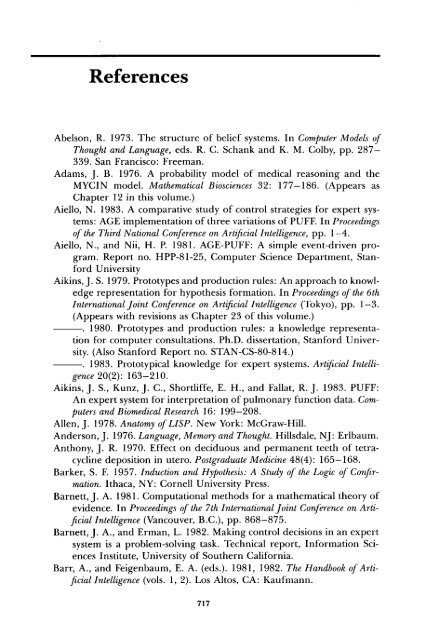
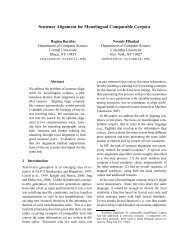
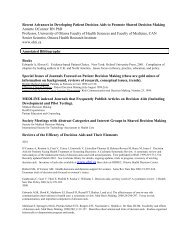
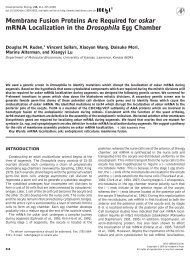
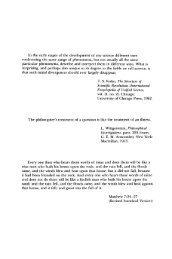
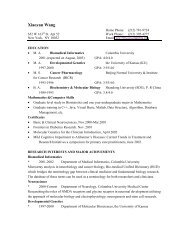
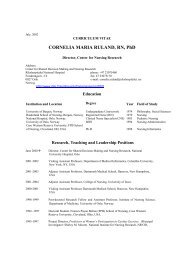
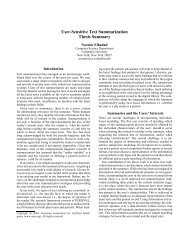
![[1998] Automated Knowledge Extraction from the UMLS - People ...](https://img.yumpu.com/31540760/1/190x245/1998-automated-knowledge-extraction-from-the-umls-people-.jpg?quality=85)
